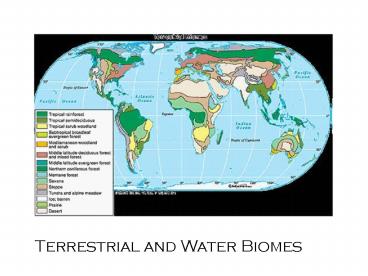Terrestrial and Water Biomes PowerPoint PPT Presentation
1 / 19
Title: Terrestrial and Water Biomes
1
- Terrestrial and Water Biomes
2
Freshwater Ecosystems
- Flowing water rivers, streams, lakes
- Standing water lakes ponds
- Wetlands
- land where water covers the soil for part of the
year. - bogs, marshes, swamps
3
(No Transcript)
4
OPEN OCEAN
5
Marine Ecosystems
- Intertidal zone where shore is exposed to air
and then submerged in seawater daily. (tidepools) - Coastal Ocean from low tide mark to continental
shelf. - Open ocean continental shelf and beyond
- Benthic zone ocean floor
- Abyss Hydrothermal vent regions, deepest ocean.
6
Coral reefs warm, shallow tropical waters.
7
Estuary
- Wetlands formed where rivers meet the ocean.
- Contain a mixture of fresh and saltwater
(brackish water). - 1. Salt marshes
- 2. Mangrove swamps
8
Savanna
- Where E. Africa, S. Brazil, N. Australia
- Isolated trees and shrubs
- Frequent fires
- Rhinos, lions, leopards, giraffes.
9
Temperate Grassland
- Where central US, Asia, Australia, S. America.
- Warm, hot summers and cold winters.
- Prairie dogs, prairie chickens, antelope, bison.
10
Temperate Forest
- Where Eastern US, Canada, Europe.
- Deciduous and coniferous trees.
- Cold winters, warm summers.
- Deer, bobcats, squirrels, racoons, skunks.
11
Rainforest
- Where S. and C. America, Africa, India
- Hot, humid year round.
- Broad evergreens, ferns, vines.
- Sloths, jaguars, parrots, butterflies, piranhas.
12
Taiga
- boreal forests
- Where N. America like Alaska, Asia, Europe
(mostly n. hemisphere) - Dense coniferous trees
- Lynx, timberwolves, moose
13
Desert
- Where Middle East, US, Mexico, Australia.
- lt25 cm rainfall per year
- Cacti and succulents
- Snakes, scorpions, bobcats, antelope, kangaroo
rats, spiders.
14
Tundra
- Where Northern N. America, Asia, Europe
- Strong winds, low precip, permafrost, cold temps,
poor soil. - Snowy owl, caribou, small rodents
15
Ecological Succession
- A series of predictable changes over a period of
time until a climax community is reached. - There are 2 types
- Primary
- Secondary
16
Primary Succession
- A community develops on a surface where no
ecosystem has existed before. (bare rock, sand
dune, an island from a volcanic eruption)
17
Secondary Succession
- A replacement of a species that follows a
disruption of an ecosystem. - Disruption may be from a forest fire, a strong
storm or human activities. - Both types of succession must have a pioneer
species. (small, fast-growing)
18
(No Transcript)
19
Climax community
- A community that remains fairly constant in
species composition if the land and climate are
undisturbed. - These are the communities that "define" the
various biomes.

